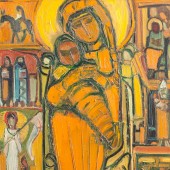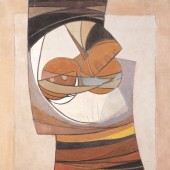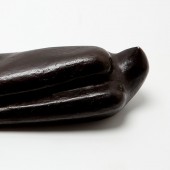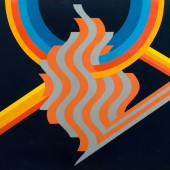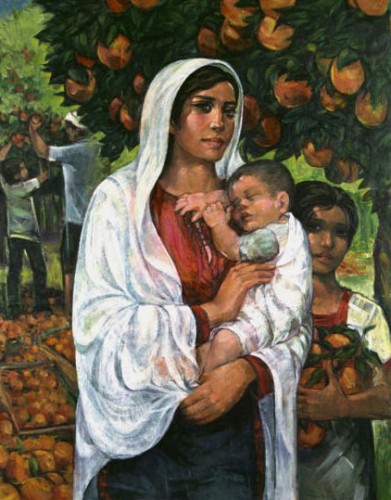
The work of celebrated Palestinian artist, Ismail Shammout is often considered a visual chronicle of Palestinian history during and after the 1948 Nakba, or “catastrophe.” Active since the early 1950s, Shammout portrays the tragedies, traditions, and determined steadfastness of the Palestinians. In this late painting, Shammout transforms the artistic icon of the Italian Renaissance—the pieta of the Madonna cradling the baby Jesus—into a young Palestinian mother. Delicately draped in a white shroud, the Palestinian Madonna stands proudly in an orange grove. With her young daughter at her side, the mother lovingly carries her sleeping baby. The three figures are framed by a lush tree, ripe with bright oranges. In the background, a man and young boy harvest the fruit. Painted in the year the artist first returned to visit his place of birth Al-Lydd after fifty years, Shammout signals the continual flowering of nature and optimism for future generations of Palestinians through the abundance of oranges and his youthful characters.
Shammout and his family were expelled from their home by Israeli forces in 1948. The aspiring artist spent his childhood in a refugee camp in Khan Younes in Gaza before enrolling at the College of Fine Arts in Cairo. Upon graduating, he held his first solo exhibition in 1953 in Gaza, where he exhibited his renowned painting, Where To? In 1954, he continued his studies in Rome, later serving as the inaugural Director of Arts and National Culture for the Palestinian Liberation Organization (PLO) in Beirut in 1965 and the Secretary General of the Union of Arab Artists in 1971. Together with his wife and fellow artist, Tamam al-Akhal, Shammout contributed to the development of an infrastructure for Palestinian art and exhibited worldwide. In 2002, Barjeel Art Foundation founder Sultan Sooud Al Qassemi visited an exhibition of Palestinian artists Ismail Shammout and Tammam Al-Akhal at the Dubai Chamber of Commerce. This was the first major exhibition by Arab artists that he had visited, an encounter that left an important mark that shaped the outlook of the collector.
يُعتبر عمل الفنان التشكيلي الفلسطيني المشهور، إسماعيل شموط في الغالب تصويراً لأحداث التاريخ الفلسطيني أثناء وبعد نكبة عام 1948. يجسد شموط مآسي الشعب الفلسطيني وتقاليده وعزمه على الصمود في مواجهة الاحتلال منذ أن بدأ امتهان الرسم في أوائل الخمسينيات من القرن الماضي. وفي عمله الحديث هذا، يستبدل شموط إحدى أشهر الأيقونات الفنية من عصر النهضة الإيطالية، وهي تمثال “بييتا” للسيدة العذراء وهي تحتضن طفلها يسوع، بأم فلسطينية شابة. وتقف هذه الأم باعتزاز وفخر في بستان من شجر البرتقال، ويغطي رأسها حجابٌ أبيض اللون يتدلى على أكتافها بسلاسة وهي تحمل طفلها النائم بين ذراعيها الحنونتين وبجانبها ابنتها الصغيرة. وتحيط بهم شجرة خضراء وارفة الظلال ومليئة بثمار البرتقال النضرة. ويظهر في خلفية اللوحة رجل وصبي يقطفان البرتقال. ورسم شموط هذه اللوحة في العام الذي عاد فيه لزيارة مسقط رأسه (مدينة اللد) بعد غياب دام 50 سنة. ويرمز في هذه اللوحة إلى ازدهار الطبيعة الدائم، كما يهدف إلى بث روح التفاؤل في الأجيال الفلسطينية القادمة عبر وفرة البرتقال والشخصيات الفتية المصوَّرة في اللوحة.
في عام 1948 طردت قوات الاحتلال الإسرائيلي شموط وعائلته من منزلهم. وأمضى هذا الفنان الطَّموح طفولته في مخيم للاجئين في خان يونس بقطاع غزة ثم التحق بكلية الفنون الجميلة في القاهرة. وفور تخرجه عام 1953 أقام أول معارضه الفنية المنفردة في غزة، حيث عرض لوحته الشهيرة “إلى أين؟”. وفي عام 1954 تابع دراساته في روما، ثم في عام 1965 شغل منصب مسؤول الفنون والثقافة الوطنية لدى منظمة التحرير الفلسطينية في بيروت، ومنصب الأمين عام لاتحاد الفنانين التشكيليين العرب عام 1971. وساهم شموط جنباً إلى جنب مع زميلته وزوجته الفنانة تمام الأكحل في تطوير أسس للفن الفلسطيني، وأقام العديد من المعارض الفنية لأعماله في جميع أنحاء العالم. في عام 2002، زار سلطان سُعود القاسمي معرضاً للفنان الفلسطيني إسماعيل شموط وزوجته تمام الأكحل، في غرفة تجارة وصناعة دبي. وكانت تلك زيارته الأولى لمعرض رئيسي لفنانين عرب، ولذلك ترك هذا اللقاء علامة فارقة في الرؤية المستقبلية له كجامع لوحات.




